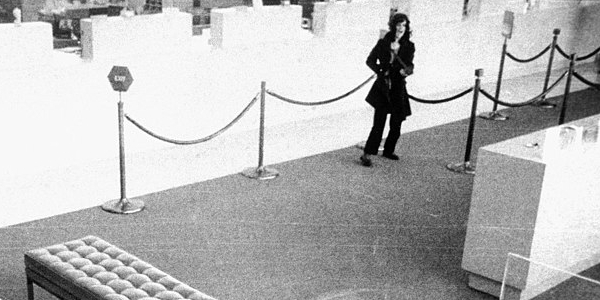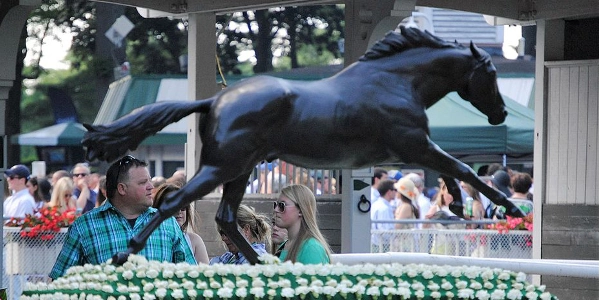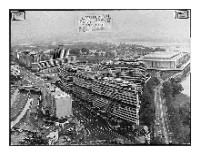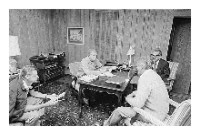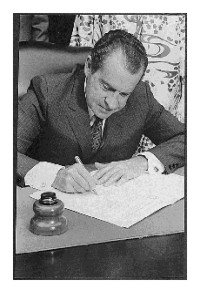
Photo above: President Richard Nixon. Courtesy National Archives. Right: Statue of Secretariat at Belmont Park, 2014, courtesy Wikipedia Commons.
Click here to Sponsor the page and how to reserve your ad.
-
Timeline
1975 - Detail
September 18, 1975 - Heiress Patty Hearst is captured after her year of kidnap and bank robbery in California. She would be convicted of the crime six months later.
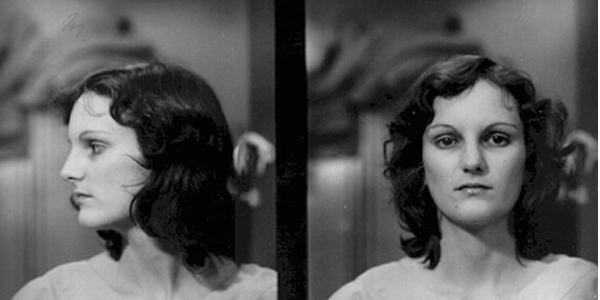
The granddaughter of one of the most influential and successful publishing icons in the world, Patty Hearst, convicted bankrobber or kidnap victim, whose conviction has been subsequently pardoned by President Bill Clinton, is, to this day, somewhat of an enigma. Are the facts fully known? Just what part in the various plots did Hearst, if any, willingly take action in? Is brainwashing a legal defense against your actions?
As the events unfolded in 1974 and 1975, prior to the event of twenty-four hour cable television, the drama of just what was happening to heiress Patty Hearst gripped the nation. It seemed, at first, that Patty Hearst had been kidnaped from her apartment near the University of California at Berkeley on February 4, 1974. The Symbionese Liberation Army, an urban guerilla group, claimed responsibility. The SLA, a small group of a dozen members, had been robbing homes and had killed an Oakland educator, Marcus Foster, whom they regarded as a fascist. It was thought that Hearst, an easy target who lived close to their hideout, could help free the two members charged with killing the educator.
The initial plan did not work. The SLA members held for Foster's murder were not released. They demanded another ransom. The Hearst family was to pay $400 million in food to the poor of the region. They paid $2 million in food; riots occurred during distribution and the army did not release Patty Hearst.

Was She a Bank Robber?
For the first six months of her captivity, the public and press regarded the Patty Hearst affair as a kidnaping and ransom arrangement. She had been beaten upon capture and kept in a closet for fifty-seven days. She was threatened with death. The SLA gave her a choice; join up and fight with them, or face dire consequences. Patty Hearst decided the best course of action was to comply and join. On April 3, 1974, Hearst released an audiotape stating that she had joined the Symbionese Liberation Army.
On April 15, 1974, the SLA robbed the Hibernia Bank; Patty Hearst was captured in the bank video as participating. Public perception of the kidnaping and reactions of federal authorities was beginning to turn. Was she a kidnap victim or participant in the bank robbery? A subsequent action in May where Hearst discharged her weapon as a warning against the capture of two SLA members in a small robbery complicated the public perception and authorities who considered that she still could be held under duress were now confronted with the thought that she could truly be a complicit member of the SLA. With this information, a grand jury indicted her for the robbery in June 1974.

Capture and Conviction
During the next year, there were rumors that Patty Hearst had been part of additional SLA crimes, which included bank robbery and assasination attempts on police. On September 18, 1975, Hearst and another SLA member were captured by the FBI. She stated, upon capture, that she was an urban guerrilla, and relayed a message, "Tell everybody that I'm smiling, that I feel free and strong and I send my greetings and love to all the sisters and brothers out there."
Experts began to assert that Patty Hearst had been brainwashed, her IQ diminished to 112 from 130 over the year, and that she was, in effect, what one doctor termed a "zombie." After several weeks, Hearst renounced her allegiance to the SLA.
The trail on the Hibernia Bank Robbery began on January 15, 1976; her defense team claimed that her partipation was involuntary, with other SLA members pointing guns at her during its completion. She was put on the jury stand, but appeared lethargic and unconvincing, failing to answer questions. She was convicted of the robbery on March 20, 1976, the jury unconvinced that Hearst had been brainwashed, and she was sentenced to seven years in prison.
Twenty-two months after her conviction and subsquent imprisonment, her sentence was commuted. On January 20, 2001, President Bill Clinton pardoned Patty Hearst.
Photo above: Mug shots of Patty Hearst after her capture by the FBI, September 19, 1975. Courtesy Wikipedia Commons. Photo below: Bank footage of Patty Hearst at the robbery of the Hibernia National Bank, April 15, 1974. Courtesy FBI via Wikipedia Commons. Source Info: Famous-trials.com; Patty Hearst Timeline, CNN; Wikipedia Commons.
